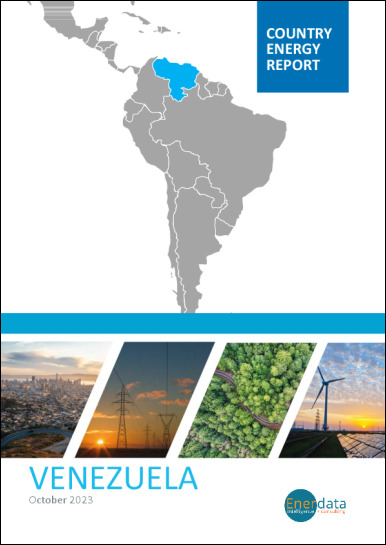- Update
-
- Format
- 3 files (PDF report, 2 Excel files)
- Pages
-
27 (Report only)
- Delivery
- Immediate by e-mail
- GENERAL OVERVIEW
- INSTITUTIONS AND ENERGY POLICY
- ENERGY COMPANIES
- ENERGY SUPPLY
- ENERGY PRICES
- ENERGY CONSUMPTION
- ISSUES AND PROSPECTS
- DATA TABLES
- ABBREVIATIONS
- GLOSSARY
Buy Venezuela energy report
Price without VAT. Depending on your statute and location, VAT might be applicable. Get in touch with us for more information.
After validation, you will immediately receive 3 files by email (one pdf report and 2 excel files containing the datasets).
Overview
This analysis includes a comprehensive Venezuela energy market report and updated datasets. It is derived from the most recent key economic indicators, supply and demand factors, oil and gas pricing trends and major energy issues and developments surrounding the energy industry. The report provides a complete picture of the country situation, dynamics, current issues and future prospects. With market data and continuous follow-up of markets news, this report brings clear and concise insights with which to tackle national energy challenges and opportunities. Browse the tabs below for a detailed table of contents, the list of graphs and tables, and details on the data files.
Highlights
- The country has been facing a severe economic and political crisis since 2013.
- The energy sector is controlled by the Government; Corpoelec is responsible for power generation and PDVSA for the oil and gas sector.
- Venezuela holds the largest proven oil reserves in the world. However, their development is limited due to the economic situation.
A significant part of the power capacity is not operational. Around half of this capacity is from hydro. - Energy prices are controlled by the Government.
Gasoline and diesel are among the lowest in the world. - Total energy consumption has rebounded since 2021, after a rapid decrease between 2013 and 2020 (-12%/year on average).
- PDVSA and Rosneft have signed several gas E&P agreements and are committed to five JVs.
Several gas-powered power plants under construction were abandoned because of the crisis.
Institutions & Energy Policy
The Energy and Oil Ministry lays down the country's energy policy and supervises all the energy companies. The Ministry of Electricity supervises the electricity sector. The Planning Ministry (Cordiplan) is involved in the development of the energy plans and the definition of the sector's main priorities.
Energy Companies
Oil:
The hydrocarbons sector is dominated by PDVSA, Petroleos de Venezuela SA (100% public). PDVSA faced default in bond payments several times in 2016 and 2017.
Energy Supply
Gas:
The natural gas production dropped by 47% from 2016 to 2020, and has since rebounded by 5%/year, reaching 16 bcm in 2023.
Only a quarter of the gas production is marketed; a strong proportion is re-injected (40%). That production is only used to supply the domestic market, with the largest part being used for the production of electricity and in industry.
Energy Prices
Oil:
The Government controls the prices. Gasoline and diesel prices are heavily subsidised: they are the lowest in the world and far below the price of crude oil.
Energy Consumption
Energy consumption per capita (1.3toe, including 2 400 kWh of electricity in 2023) is relatively high compared to the level of income per capita.
Primary energy consumption has rebounded by 10%/year since 2023 to 37 Mtoe, after a decrease at an average rate of 12%/year between 2013 and 2020.
Issues & Prospects
The development of Venezuela's large reserves is blocked by the on-going economic and political crisis.
 Energy and Climate Databases
Energy and Climate Databases Market Analysis
Market Analysis